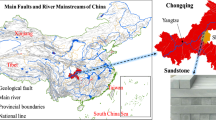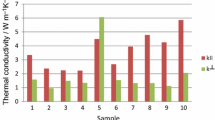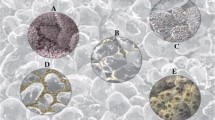Abstract
Understanding and modelling the wettability of tight rocks is essential for designing fracturing and treatment fluids. In this paper, we measure and analyze spontaneous imbibition of water and oil into five twin core plugs drilled from the cores of a well drilled in the Montney Formation, an unconventional oil and gas play in the Western Canadian Sedimentary Basin. We characterize the samples by measuring the mineralogy using XRD (x-ray diffraction), total organic carbon content, porosity, and permeability. Interestingly, the equilibrated water uptake of the five samples is similar, while, their oil uptake increases by increasing the core porosity and permeability. We define two wetta-bility indices for the oil phase based on the slope and equilibrium values of water and oil imbibition curves. Both indices increase by increasing porosity and permeability, with the slope affinity index showing a stronger correlation. This observation suggests that part of the pore network has a stronger affinity to oil than to water. We also observe that the two indices decrease by increasing neutron porosity and gamma ray parameters measured by wireline logging tools. The samples with higher gamma ray and neutron porosity are expected to have greater clay content, and thus less effective porosity and permeability.
Similar content being viewed by others
References Cited
Aloulou Fawzi, M. F., Meg Coleman, 2014. Tight Oil Production Pushes U.S. Crude Supply to over 10% of World Total.
Amott, E., 1959. Observations Relating to the Wettability of Porous Media. AIME (216): 156–162
Anderson, W., 1986. Wettability Literature Survey-Part 2: Wettability Measurement. Journal of Petroleum Technology, 38(11): 1246–1262. doi: 10.2118/13933-pa
Borysenko, A., Clennell, B., Sedev, R., et al., 2009. Experimental Investigations of the Wettability of Clays and Shales. Journal of Geophysical Research: Solid Earth, 114(B7). doi: 10.1029/2008jb005928
Brown, R. J. S., Fatt, I., 1956. Measurements of Fractional Wettability of Oil Fields' Rocks by the Nuclear Magnetic Relaxation Method. In: Fall Meeting of the Petroleum Branch of AIME. doi: 10.2118/743-g
Cai, J., Yu, B., 2011. A Discussion of the Effect of Tortuosity on the Capillary Imbibition in Porous Media. Transport in Porous Media, 89(2): 251–263. doi: 10.1007/s11242-011-9767-0
Carrier III, W. D., 2003. Goodbye, Hazen; Hello, Kozeny-Carman. Journal of Geotechnical and Geoenvironmental engineering, 129(11): 1054–1056. doi: 10.1061/(asce)1090-0241(2003)129: 11(1054)
Dehghanpour, H., Lan, Q., Saeed, Y., et al., 2013. Spontaneous Imbibition of Brine and Oil in Gas Shales: Effect of Water Adsorption and Resulting Microfractures. Energy & Fuels, 27(6): 3039–3049. doi: 10.1021/ef4002814
Donaldson, E. C., Thomas, R. D., Lorenz, P. B., 1969. Wettability Determination and Its Effect on Recovery Efficiency. Soc. Petrol. Eng. 9(1): 13–20. doi: 10.2118/2338-pa
Freedman, R., Heaton, N., Flaum, M., et al., 2003. Wettability, Saturation, and Viscosity from NMR Measurements. SPE Journal, 8(04): 317–327. doi: 10.2118/87340-pa
Ghanbari, E., Dehghanpour, H., 2016. The Fate of Fracturing Water: A Field and Simulation Study. Fuel, 163: 282–294. doi: 10.1016/j.fuel.2015.09.040
Habibi, A., Binazadeh, M., Dehghanpour, H., et al., 2015. Advances in Understanding Wettability of Tight Oil Formations. SPE Annual Technical Conference and Exhibition. 19. doi: 10.2118/175157-ms
Handy, L., 1960. Determination of effective Capillary Pressures for Porous Media from Imbibition Data. Trans. AIME, 219: 75–80.
Herron, M. M., 1988. Geochemical Classification of Terrigenous Sands and Shales from Core or Log Data. Journal of Sedimentary Research, 58(5). doi: 10.1306/212f8e77-2b24-11d7-8648000102c1865d
Jones, S. C., Roszelle, W. O., 1978. Graphical Techniques for Determining Relative Permeability from Displacement Experiments. J. Petrol. Technol. 30(5): 807–817. doi: 10.2118/6045-pa
Kai, O., Shidong, 2013. Overview of Nanofluid for EOR and Its Effect on Wettability. NTNU
Kendall, D. R., 1999. Sedimentology and Stratigraphy of the Lower Triassic Montney Formation, Peace River Basin, Subsurface of Northwestern Alberta. University of Calgary
Kwok, D. Y., Neumann, A. W., 1999. Contact Angle Measurement and Contact Angle Interpretation. Advances in colloid and interface science, 81(3): 167–249. doi: 10.1016/s0001-8686(98)00087-6
Lan, Q., Ghanbari, E., Dehghanpour, H., et al., 2014. Water Loss versus Soaking Time: Spontaneous Imbibition in Tight Rocks. Energy Technology, 2(12): 1033–1039. doi: 10.1002/ente.201402039
Lan, Q., Dehghanpour, H., Wood, J., et al., 2015. Wettability of the Montney Tight Gas Formation. SPE Reservoir Evaluation & Engineering 18(3): 417–431. doi: 10.2118/171620-pa
Law, B. E., Spencer, C. W., 1993. Gas in Tight Reservoirs——An Emerging Major Source of Energy. United States Geological Survey, Professional Paper, 1570
Morrow, N., Ma, S., Zhou, X., et al., 1994. Characterization of Wettability from Spontaneous Imbibition Measurements. Annual Technical Meeting
Morrow, N. R., 1975. The Effects of Surface Roughness on Contact: Angle with Special Reference to Petroleum Recovery. Journal of Canadian Petroleum Technology, 14(04): 256–298. doi: 10.2118/94-47
Morrow, N. R., 1990. Wettability and Its Effect on Oil Recovery. J. Petrol. Technol. (42): 1476–1484. doi: 10.2118/21621-pa
Nelson, P. H., 2009. Pore-Throat Sizes in Sandstones, Tight Sandstones, and Shales. 93: 329–340. doi: 10.1306/10240808059
Odusina, E. O., Sondergeld, C. H., Rai, C. S., 2011. NMR Study of Shale Wettability. Canadian Unconventional Resources Conference. doi: 10.2118/147371-ms
Peters, K., 1986. Guidelines for Evaluating Petroleum Source Rock Using Programmed Pyrolysis. AAPG Bulletin, 70(3): 318–329. doi: 10.1306/94885688-1704-11d7-8645000102c1865d
Washburn, K. E, Birdwell, J. E., 2013. A New Laboratory Approach to Shale Analysis Using NMR Relaxometry. In: The SPE conference at Unconventional Resources Technology Conference
Acknowledgments
We thank Encana Corporation for providing the rock samples and petrophysical data, and NSERC (Natural Science and Engineering Research Council of Canada) for supporting this work. The final publication is available at Springer via http://dx.doi.org/10.1007/s12583-017-0725-9.
Author information
Authors and Affiliations
Corresponding author
Additional information
Ali Javaheri: http://orcid.org/0000-0002-4790-0925
Hassan Dehghanpour: http://orcid.org/0000-0002-1434-3237
Rights and permissions
About this article
Cite this article
Javaheri, A., Dehghanpour, H. & Wood, J.M. Tight rock wettability and its relationship to other petrophysical properties: A Montney case study. J. Earth Sci. 28, 381–390 (2017). https://doi.org/10.1007/s12583-017-0725-9
Received:
Accepted:
Published:
Issue Date:
DOI: https://doi.org/10.1007/s12583-017-0725-9




